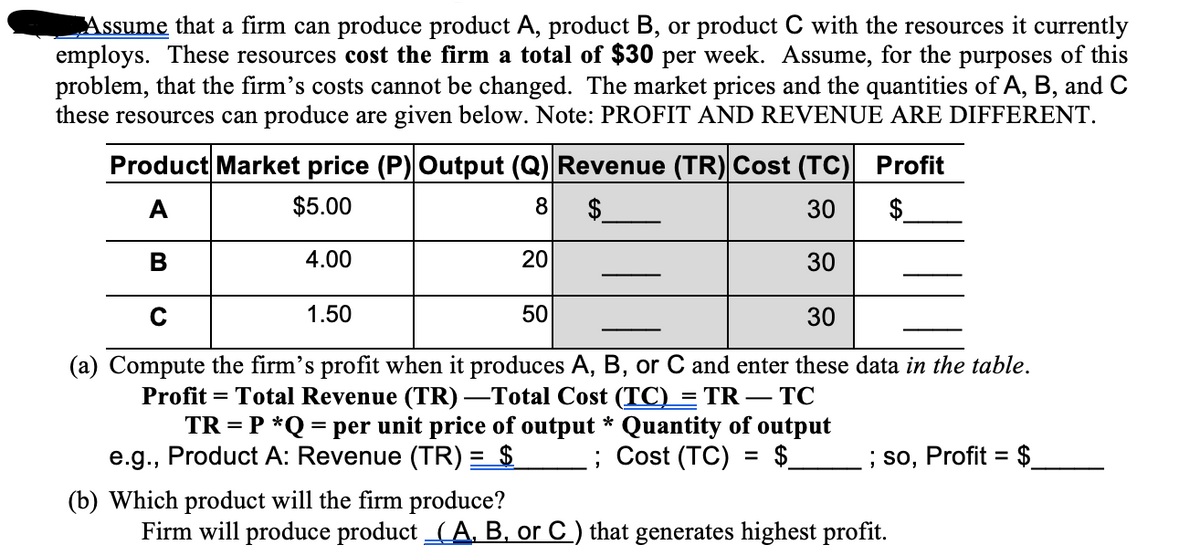sume that a firm can produce product A, product B, or product C with the resources it currently ys. These resources cost the firm a total of $30 per week. Assume, for the purposes of this em, that the firm's costs cannot be changed. The market prices and the quantities of A, B, and C resources can produce are given below. Note: PROFIT AND REVENUE ARE DIFFERENT. Product Market price (P) Output (Q) Revenue (TR) Cost (TC) Profit А $5.00 8 30 $. 4.00 20 30 1.50 50 30 Compute the firm’s profit when it produces A, B, or C and enter these data in the table. Profit = Total Revenue (TR) –Total Cost (TC) = TR – TC TR = P *Q = per unit price of output * Quantity of output e.g., Product A: Revenue (TR) = $ ; Cost (TC) = $ ; so, Profit = $. %3D Which product will the firm produce? Firm will produce product _(A, B, or C ) that generates highest profit.
sume that a firm can produce product A, product B, or product C with the resources it currently ys. These resources cost the firm a total of $30 per week. Assume, for the purposes of this em, that the firm's costs cannot be changed. The market prices and the quantities of A, B, and C resources can produce are given below. Note: PROFIT AND REVENUE ARE DIFFERENT. Product Market price (P) Output (Q) Revenue (TR) Cost (TC) Profit А $5.00 8 30 $. 4.00 20 30 1.50 50 30 Compute the firm’s profit when it produces A, B, or C and enter these data in the table. Profit = Total Revenue (TR) –Total Cost (TC) = TR – TC TR = P *Q = per unit price of output * Quantity of output e.g., Product A: Revenue (TR) = $ ; Cost (TC) = $ ; so, Profit = $. %3D Which product will the firm produce? Firm will produce product _(A, B, or C ) that generates highest profit.
Managerial Economics: A Problem Solving Approach
5th Edition
ISBN:9781337106665
Author:Luke M. Froeb, Brian T. McCann, Michael R. Ward, Mike Shor
Publisher:Luke M. Froeb, Brian T. McCann, Michael R. Ward, Mike Shor
Chapter7: Economies Of Scale And Scope
Section: Chapter Questions
Problem 5MC
Related questions
Question

Transcribed Image Text:Assume that a firm can produce product A, product B, or product C with the resources it currently
employs. These resources cost the firm a total of $30 per week. Assume, for the purposes of this
problem, that the firm's costs cannot be changed. The market prices and the quantities of A, B, and C
these resources can produce are given below. Note: PROFIT AND REVENUE ARE DIFFERENT.
Product Market price (P) Output (Q) Revenue (TR) Cost (TC) Profit
A
$5.00
8
$.
30
$.
В
4.00
20
30
1.50
50
30
(a) Compute the firm's profit when it produces A, B, or C and enter these data in the table.
Profit = Total Revenue (TR) –Total Cost (TC) = TR – TC
TR = P *Q = per unit price of output * Quantity of output
e.g., Product A: Revenue (TR) = $
-
; Cost (TC)
; so, Profit = $
= $
(b) Which product will the firm produce?
Firm will produce product _(A. B, or C ) that generates highest profit.
Expert Solution
This question has been solved!
Explore an expertly crafted, step-by-step solution for a thorough understanding of key concepts.
Step by step
Solved in 3 steps

Knowledge Booster
Learn more about
Need a deep-dive on the concept behind this application? Look no further. Learn more about this topic, economics and related others by exploring similar questions and additional content below.Recommended textbooks for you

Managerial Economics: A Problem Solving Approach
Economics
ISBN:
9781337106665
Author:
Luke M. Froeb, Brian T. McCann, Michael R. Ward, Mike Shor
Publisher:
Cengage Learning


Economics (MindTap Course List)
Economics
ISBN:
9781337617383
Author:
Roger A. Arnold
Publisher:
Cengage Learning

Managerial Economics: A Problem Solving Approach
Economics
ISBN:
9781337106665
Author:
Luke M. Froeb, Brian T. McCann, Michael R. Ward, Mike Shor
Publisher:
Cengage Learning


Economics (MindTap Course List)
Economics
ISBN:
9781337617383
Author:
Roger A. Arnold
Publisher:
Cengage Learning
